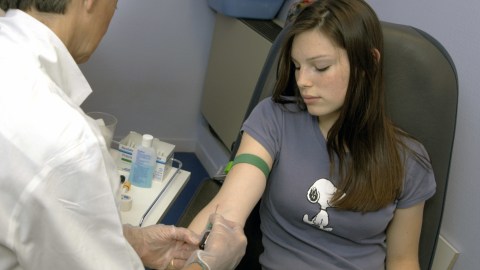Can aging be reversed by getting blood transfusions from young people?

Silicon Valley bigwig Peter Thiel is a big fan of immortality. He’s using a lot of his biotech fortune to fund research aiming to reverse and ultimately stop the biological deterioration also known as aging. His latest idea is to inject young people’s blood into himself. If that sounds like modern-day vampirism, you’re correct.
Almost every culture in the world has a version of the vampire myth. In all of them, the vampire must ingest the blood of the living in order to retain its immortality. While humans created the monster, the belief in the life-giving properties of blood has been with us for millennia.
The first researcher to figure this out was Wanda Ruth Lunsford. She was a 26-year-old scientist working in New York City. She put an old rat and a young rat to sleep and tied their skin together. The rats’ blood supplies joined, and after several weeks the old rat had new neurons growing in its brain. The old rat also had a stronger heartbeat, bigger muscles, and brown hair instead of gray hair. Those results made Lunsford believe young blood could scientifically reverse the aging process. Professor David Agus backs her up:
While Lunsford was run out of the scientific community, scientists found her conclusions compelling. This year, laboratories at Harvard, Stanford, and University of California San Francisco not only repeated her experiment; it replicated her results. The exact reasons for those results are unclear, but the most likely culprit may be blood plasma.
Additional scientific testing on mice has shown that giving old mice blood plasma from young mice improves muscle function, cognition, and even sense of smell. Even more striking, those same studies showed that transfusing old blood into young mice sped up signs of aging. The results happened whether the mice’s circulatory systems were surgically combined or simple injections of blood plasma, but further tests are needed to determine why.
Yet one of the key culprits of blood plasma that may be causing these results is its ability to transport stem cells. Stem cells, according to The Mayo Clinic, are “the body’s raw materials — cells from which all other cells with specialized functions are generated.” Those cells can generate new cells, and those cells “can either become new stem cells (self-renewal) or specialized cells (differentiation) with a more specific function, such as blood cells, brain cells, heart muscle or bone. No other cell in the body has the natural ability to generate new cell types.”
Stem cells are important and powerful — but as Dr. Agus explains in the video above, they shut off at age 25. That’s why researchers are now focusing on blood transfusions from people under that age. One US company pursuing this research is Ambrosia, who hopes to inject 35-year-olds with the blood plasma of 25-year-olds. They’re hoping to examine the effects of those stem cells in the older participants, and are currently hoping to recruit 600 volunteers. Given that they’re charging participants $8,000 for each injection, their participant list may be skewed toward the Silicon Valley crowd. Similar studies in China and Korea are pursuing this line of research, too, albeit without the steep cost.
The science may sound more like fiction than fact, but it’s not. The FDA has approved blood for off-label prescription uses, provided its results are not guaranteed. That clearance, combined with the fact that the majority of the funds for this research are being provided by Silicon Valley, means blood might become a premium anti-aging treatment solely for the uber-rich. Putting that kind of medicine in the hands of people paying for its outcome is problematic. Hopefully, if promising results come in, more objective research can advance it for everyone’s benefit.
—





